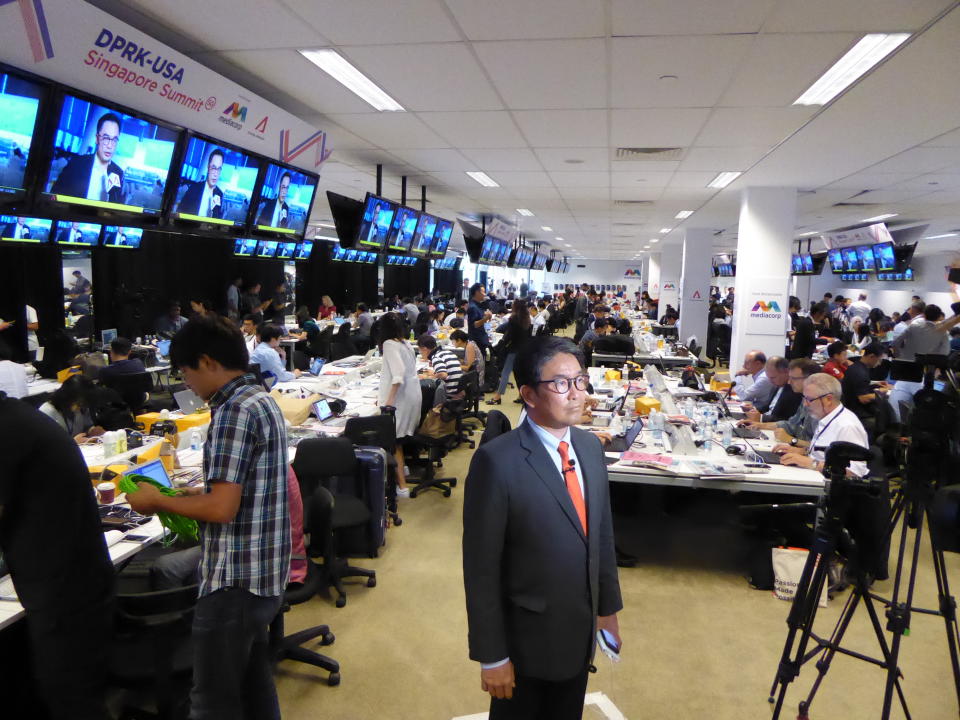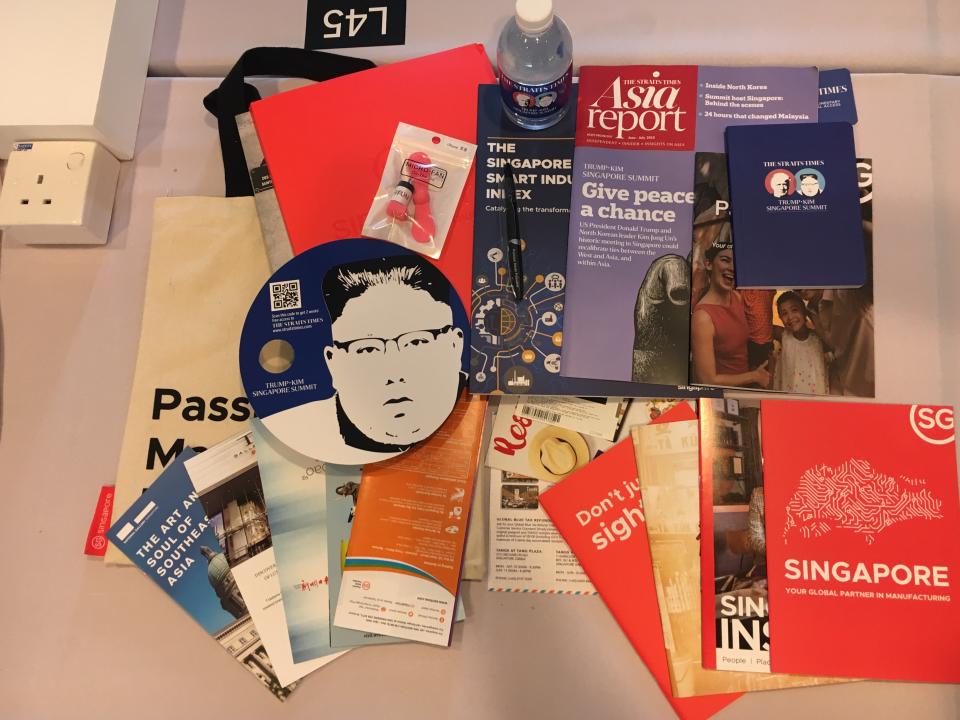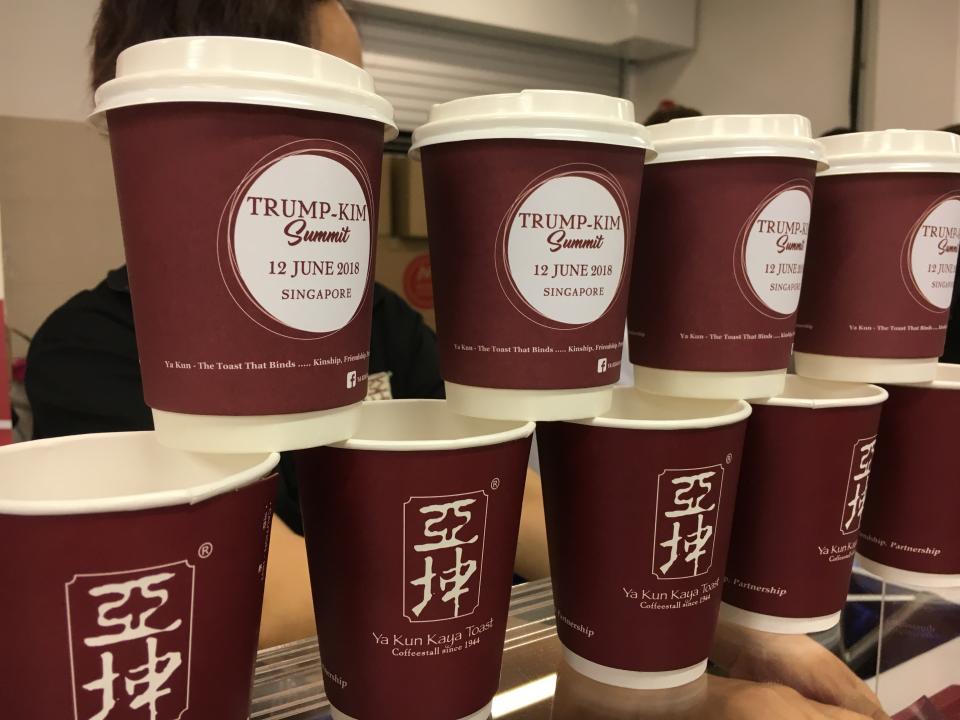COMMENT: Trump-Kim summit and the Singapore complex to impress the world

If there is an image that sums up the experience of covering the Trump-Kim summit for many journalists, it is a photo tweeted by Bloomberg News journalist Toluse Olorunnipa. It shows around a dozen reporters crowded around a TV at JW Marriot South Beach, straining to hear what was being said at the meeting between US President Donald Trump and North Korean leader Kim Jong Un.
Not too far away from the hotel, those of us in the International Media Centre (IMC) at the F1 Pit Building also struggled to make out the ‘live’ feed provided by Mediacorp, the official broadcaster for the event. As a Korean journalist remarked to this reporter, “The ‘live’ feed is very important, otherwise journalists are no different from people watching TV.”
The Washington Post’s John Hudson summed it up well when he drily remarked in a tweet, “The frustration of flying all the way to Singapore to cover a television screen with low volume.”
Reporters in press filing center try to hear audio of Trump's meeting with Kim Jong Un. pic.twitter.com/gVb4w3Uk1F
— Toluse Olorunnipa (@ToluseO) June 12, 2018
Poor audio quality aside, this was the predicament that the vast majority of the more than 2,500 reporters covering the event found themselves in: we could not get into the room for the summit, the extended bilateral meeting between the US and North Korea or the subsequent press conference by Trump. While it was impossible to give every accredited reporter the same level of access, covering one of the biggest news events in decades turned out to be a somewhat surreal experience for many of us.
Besides watching the ‘live’ broadcast and waiting for transcripts and footage from Mediacorp and government officials, many were reduced to interviewing fellow journalists and filing ‘live’ reports from the IMC. Others, including this reporter, staked out the hotels where Trump and Kim were staying, as well as the Istana, where they met Singapore Prime Minister Lee Hsien Loong. Much of the coverage amounted to photos and videos of their motorcades and security personnel.
Nevertheless, foreign journalists told Yahoo News Singapore that the organisation of the event was largely exemplary. In almost two decades of reporting, American Kristin Dailey has covered many high-level events such as the G7 summit. When asked about the planning for the Trump-Kim summit, she said, “This is a global level of excellence in terms of security and organisation, plus added and unexpected hospitality. Everything is very organised.”
Please like us. Please.

World peace is nice if you can get it, but Dailey’s comments speak to the organisers’ true priorities: putting on a good show. And the government certainly seemed eager to “put forward our best face to the world”, as Foreign Minister Vivian Balakrishnan put it.
And so the government did, along with partners in the private sector, to lay the grandest welcome mat ever in Singapore’s history for what North Korean media trumpeted as the “meeting of the century”. Even Chua Mui Hoong, Opinion Editor of national broadsheet The Straits Times (ST), urged Singaporeans to put on smiles for the world to see during the summit, something that tourists who have attended the Arirang Festival in Pyongyang could relate to, having witnessed the Cheshire cat smiles of North Koreans there.
An elaborate spread was catered for the assembled journalists at the IMC, featuring 45 dishes across 15 cuisines and five meals provided each day, not to mention beverages and snacks available 24 hours a day. Local and foreign companies who provided the catering were reportedly asked to sponsor their offerings, though the likes of Ya Kun Kaya Toast were shrewd enough to provide takeaway cups with the message “Trump-Kim summit, 12 June 2018”.
The entire event was a massive branding exercise for Singapore. For example, the media kit issued to every reporter also contained items such as tourism brochures on Singapore, souvenirs branded with ST’s name, and bizarrely, a half-price ticket to Universal Studios Singapore and the S.E.A. Aquarium. Everything was placed in a tote bag emblazoned with Singapore’s official brand: “Passion Made Possible”.
QZ reporter Isabella Steger even tweeted that the Singapore Tourism Board asked the management of the buildings in the Marina Bay area to keep their lights on through the night, in order to showcase the city skyline for the media.
There were even “complimentary learning visits” organised for journalists, consisting of visits to the Botanic Gardens and Punggol housing estate.

With many Singaporeans asking the same question – “Why are we spending $20 million on this event?” – who could blame the organisers for milking the event for all it’s worth? But it all felt a bit like the boyfriend meeting his prospective in-laws for the first time and yearning for them to like him. While the parents would appreciate the effort, they also wish he wouldn’t try quite so hard.
While being a good host is undoubtedly important, it also speaks to the age-old insecurity that lies at the heart of a government that regularly tasks its ambassadors to rebut foreign media outlets critical of some of its policies. In this regard, perhaps Balakrishnan should have thought about the headlines that would ensue when he took his cringeworthy selfie alongside a ruthless dictator like Kim and Education Minister Ong Ye Kung, whom The Guardian captioned in its article as an “unknown man”.
And what was all that effort rewarded with? Numerous figures have been bandied about, with media intelligence firm Meltwater even claiming that Singapore may have gained more than $700 million in exposure. We also ended up on the front pages of North Korean newspapers, which are notorious for doctoring photos to show the ills of capitalism in the US and South Korea.
Personally, this is my biggest takeaway from the summit: a US State Department memo that somehow called Singapore a part of Malaysia. My first thought: At long last, they know we’re not in China.
Related stories:
North Korea media herald Kim’s Singapore stroll
Trump-Kim summit: Journalist escorted away by police on Sentosa amid media fracas


